When it comes to securing your home, windows are often the most vulnerable entry points. While doors usually get the most attention, burglars frequently target windows because they can be easier to force open or break.
That’s where window alarm sensors come in. These small but powerful devices provide an extra layer of protection, alerting you immediately if someone attempts to tamper with your windows.
In this guide, we’ll cover everything you need to know about window alarm sensors—from how they work to the different types available and tips for choosing the right ones for your home.
What are Window Alarm Sensors?
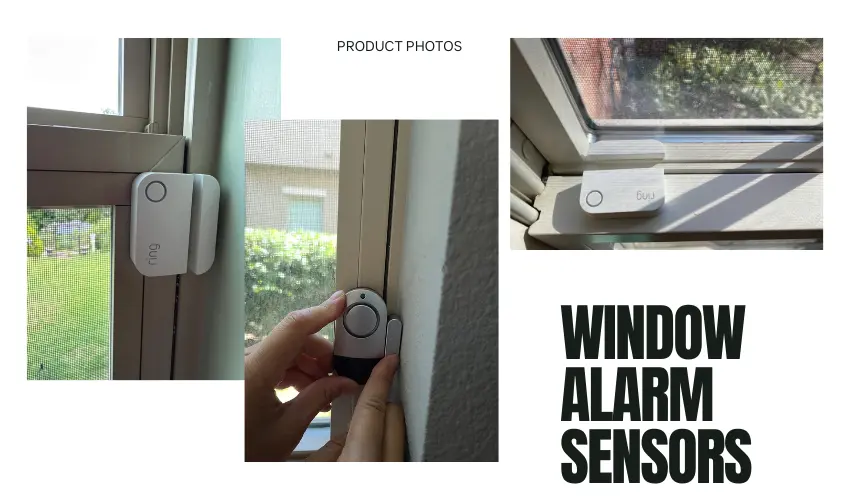
Intruders break into your home through various openings, such as:
- The front door
- Back door
- Garage door
- Windows
Windows are one of the most popular points of entry for intruders because many people forget to lock their windows, let alone have added security features. This makes it even more crucial to ensure that your windows are secure and prepared for any eventuality.
Window alarm sensors work similarly to door alarm sensors, in that they let you know if someone tries to access your home through a window. The way they work is through a switch and a magnet attached to your windowpane and frame.
The magnet allows the switch’s circuit to stay intact while the window is closed. But the opening of the window pulls the magnet away from the switch. This is when the circuits open and send a signal to sound the alarm, notifying you of an intruder attempting to enter your home.
Wireless window sensors are the most popular option for homeowners, and they’re relatively easy to install. They only take a few minutes of work to be ready to go.
Types of Window Alarm Sensors
There are several types of window alarm sensors to consider, each offering unique protection:
-
Magnetic Contact Sensors
-
Consist of two parts: one on the window frame and one on the sash.
-
Trigger an alarm if the window is opened and the magnetic connection breaks.
-
Affordable and easy to install.
-
-
Glass-Break Sensors
-
Detect the sound frequency or vibrations of breaking glass.
-
Ideal for large windows or sliding glass doors.
-
Can cover multiple windows in one room.
-
-
Shock Sensors
-
React to vibrations or impact on the window.
-
Trigger alerts before the glass is even broken.
-
-
Smart Window Sensors
-
Connect to your Wi-Fi or smart home system.
-
Send instant alerts to your smartphone.
-
Allow integration with other smart devices like cameras or alarms.
-
Benefits of Window Alarm Sensors
-
Deterrence: Visible sensors can discourage burglars from targeting your home.
-
Instant Alerts: Immediate notifications help you act quickly in case of an attempted break-in.
-
Customizable Security: Different sensor types cover various risks, from forced entry to glass shattering.
-
Easy Installation: Many sensors are DIY-friendly and battery-powered.
-
Smart Integration: Modern sensors can integrate with Alexa, Google Assistant, or your full security system.
Top Window Alarm Sensors for Your Home
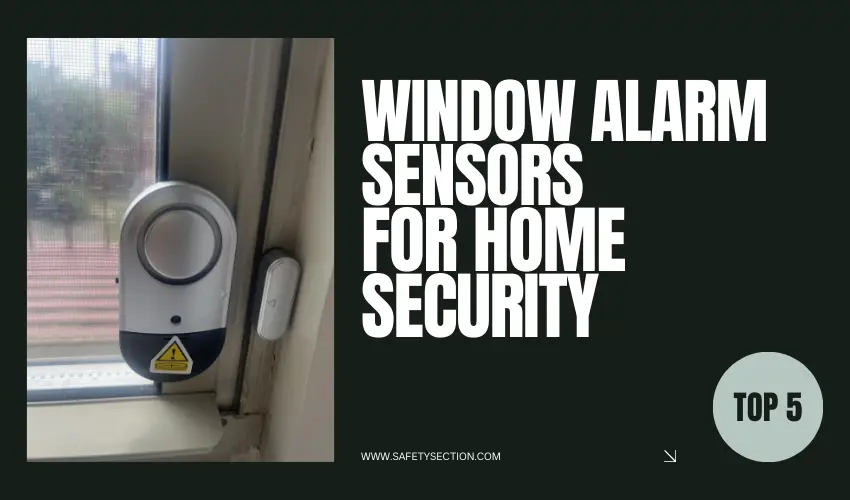
The security of your home depends on the window alarm sensors you choose to install, so it’s important to pick the right one.
When searching for the best window alarm sensor, ask yourself these questions:
- What do your windows look like?
- How many windows do you have?
- Do you want a sensor for each window?
To get you started on your journey to better home security, here are the best window alarm sensors to consider for your home.
5 Best Window Alarm Sensors
1. Ring Alarm Contact Sensor
The Ring Alarm Contact Sensor 2-Pack (2nd Gen) is a reliable and user-friendly solution for enhancing your home security. With its slim, compact design, it fits easily on doors and windows without looking bulky, offering more placement flexibility than the previous generation. Installation is quick and tool-free, making it perfect for DIY setups.
The sensors provide instant mobile alerts (with a Ring Protect subscription) when a door or window is opened, keeping you informed no matter where you are. Powered by two CR2032 batteries with an impressive 3-year lifespan, they require minimal maintenance.
Keep in mind, they do require the Ring Alarm Base Station to function, so they’re best suited for households already using the Ring Alarm ecosystem.
Overall: A sleek, dependable, and easy-to-use sensor set that integrates seamlessly with Ring’s security system, offering peace of mind at an affordable price.
2. EVA LOGIK Modern Ultra-Thin Window Alarm
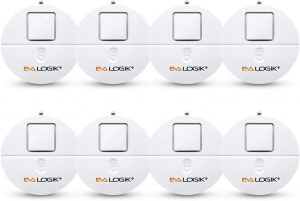
The EVA LOGIK Ultra-Thin Window Alarm is a smart, affordable way to boost your home or office security. With its built-in vibration sensor, the alarm instantly triggers a powerful 120dB siren when it detects window vibrations or glass breakage—effectively deterring intruders while alerting you and those nearby.
One standout feature is its customizable sensitivity settings, allowing you to switch between high and low modes to minimize false alarms while maintaining reliable detection. The flashing LED warning light serves as both a visual deterrent and a low-battery indicator, ensuring the system stays functional.
Installation is simple and completely wire-free—just use the adhesive backing to secure it in place. Powered by two AAA batteries (not included), the alarm offers long-lasting performance with fewer replacements needed. Its slim, modern design makes it compatible with virtually any type of window, while the included deterrent stickers provide an extra layer of security.
Overall: The EVA LOGIK Ultra-Thin Window Alarm is a practical and effective choice for anyone looking to add strong, budget-friendly protection to their home, office, dorm, RV, or garage without a complicated setup.
3. Toeeson Door Window Alarm
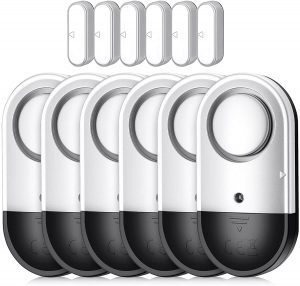
The Toeeson Door & Window Alarm is a budget-friendly yet effective security solution for homes, offices, stores, and even RVs. Delivering a 120dB siren audible up to 750 feet, it quickly alerts you to unauthorized entry while also serving as a helpful door chime to monitor kids or pets.
Its ultra-slim design (just 3.0″ x 1.5″ x 0.63″) makes it discreet and versatile enough for doors, windows—including sliding and crank styles—and even poolside safety. With two modes (alarm/chime), it’s easy to adapt for different uses.
Installation is completely DIY-friendly with strong adhesive backing—no tools or wiring needed. Each unit comes with 4x LR44 batteries pre-installed and a low-battery indicator so you’ll know when it’s time for replacements. The set includes 6 alarms, making it a great value for whole-home coverage.
Overall: The Toeeson Door & Window Alarm offers a reliable, easy-to-install, and affordable way to enhance home security. Its loud alarm, slim build, and multiple uses make it a solid choice for families and renters alike.
4. Flyoukki Door and Window Open Alarm Sensor

The Flyoukki 120dB Alarm Sensors offer a simple, effective, and affordable way to boost home and family safety. With a blaring 120dB alarm audible up to 750 feet, they’re ideal for deterring intruders, monitoring kids, or keeping dementia patients safe from wandering.
Each unit is wireless and battery-powered (3 LR44 batteries included, lasting 6–12 months) with a low-battery indicator, so you’ll always know when replacements are needed. Installation is fast and tool-free—just peel and stick with the included adhesive. The slim, discreet design blends easily with any door, window, cabinet, or poolside entry.
This 3-pack even includes anti-noise earplugs for safe setup. While not UL-2017 compliant for pool inspections, they’re an excellent everyday safety measure for homes, apartments, offices, and more.
Overall: Compact, reliable, and easy to use, the Flyoukki alarms provide peace of mind for families seeking budget-friendly security.
5. GE Personal Security Window and Door Alarm
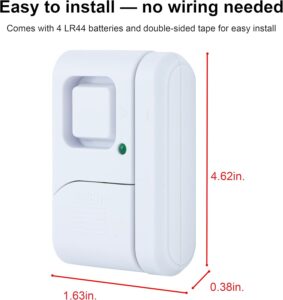
The GE Personal Security Window and Door Alarms provide a simple, affordable way to secure multiple entry points in your home, apartment, or garage. Each unit features a 120dB alarm or chime option, triggered by a magnetic sensor when a door or window is opened—loud enough to deter intruders or simply alert you of entry.
Setup is quick and tool-free with the included double-sided tape, making them ideal for renters, RVs, or temporary use. The three-mode switch (OFF/CHIME/ALARM) gives flexibility, and each alarm comes with four LR44 batteries included, plus a test button and low-battery indicator for reliability.
Compact and portable, this 12-pack covers your whole home, from main doors to windows, garages, sheds, or even office cabinets.
Overall: A budget-friendly, easy-to-install security solution that offers peace of mind with wide coverage and dependable performance.
Comparison Table: 5 Best Window Alarm Sensors
Here’s a clear comparison table of their key features:
Product |
Alarm Volume |
Sensor Type |
Power |
Installation |
Pack Size |
Special Features |
|---|---|---|---|---|---|---|
Ring Alarm Contact Sensor (2nd Gen) |
N/A (alerts via app, not loud alarm) |
Magnetic contact |
2 × CR2032 batteries (≈3 years) |
Adhesive, tool-free |
2 |
Mobile alerts (Ring Protect subscription), slim design, requires Ring Base Station |
EVA LOGIK Ultra-Thin Window Alarm |
120 dB |
Vibration sensor (detects glass breaks/movement) |
2 × AAA batteries (not included) |
Adhesive |
8 |
Adjustable sensitivity (high/low), flashing LED deterrent, sleek ultra-thin design, and warning stickers |
Toeeson Door Window Alarm |
120 dB |
Magnetic contact |
4 × LR44 batteries (included) |
Adhesive |
6 |
Two modes (alarm/chime), ultra-slim design, low-battery indicator |
Flyoukki Door & Window Alarm |
120 dB |
Magnetic contact |
3 × LR44 batteries (included) |
Adhesive |
3 |
Sleek ultra-slim design, low-battery indicator, includes earplugs, works with doors, windows, and cabinets |
GE Personal Security Window & Door Alarm |
120 dB |
Magnetic contact |
4 × LR44 batteries (included) |
Adhesive |
12 |
Multi-mode switch (OFF/CHIME/ALARM), low-battery indicator, portable design |
Quick Take:
-
Best Smart Option → Ring Contact Sensor (integrates with Ring system, app alerts).
-
Best for Glass Breaks → EVA LOGIK (vibration sensor + adjustable sensitivity).
-
Best Value Pack → GE Security Alarms (12-pack) for full-home coverage.
-
Best Mid-Size Pack → Toeeson (6-pack) with alarm/chime modes.
-
Best Compact & Simple → Flyoukki (3-pack) with sleek design + earplugs included.
Factors to Consider Before Buying
When choosing window alarm sensors, keep these points in mind:
-
Type of Windows: Sliding, double-hung, and casement windows may require different sensor styles.
-
Coverage Area: Decide whether you need individual sensors for each window or a glass-break sensor for multiple windows.
-
Power Source: Battery-powered sensors are easy to install, while wired options may require professional setup.
-
Compatibility: Ensure the sensors integrate with your existing security system or smart home hub.
-
Budget: Prices vary from budget-friendly magnetic contacts to advanced smart sensors.
Installation and Maintenance Tips
-
Install sensors at the top or side of the window where they won’t be easily tampered with.
-
Test your sensors regularly to ensure they’re working properly.
-
Replace batteries as needed, usually every 6–12 months.
-
Clean sensors to prevent dust or dirt from interfering with performance.
Frequently Asked Questions
1. How do window alarm sensors work?
Most window alarms use magnetic contact sensors or vibration sensors.
-
Magnetic sensors trigger an alarm when the window is opened and the magnet separates from the sensor.
-
Vibration sensors detect impact or glass breakage and sound an alarm.
Both types provide a loud alert to deter intruders and notify occupants.
2. Are window alarm sensors easy to install?
Yes. Nearly all consumer window alarms are DIY-friendly and use adhesive backing for quick mounting—no wiring or drilling required. Installation usually takes just a few minutes. Some smart sensors (like Ring or SimpliSafe) may require a compatible hub or base station.
3. Do window alarms work if the power goes out?
Yes. Window alarms are battery-powered, so they remain active during power outages. Many models also include a low-battery indicator or LED light so you’ll know when it’s time to replace the batteries.
4. Can window alarms prevent break-ins?
Window alarms act as a deterrent rather than a guaranteed barrier. The loud 120dB siren can scare off intruders and alert you or neighbors to suspicious activity. While they don’t physically stop break-ins, they add an extra layer of protection and peace of mind.
5. What features should I look for when buying window alarms?
Key features to consider include:
-
Alarm volume (louder is better, typically 120dB)
-
Type of sensor (magnetic vs. vibration/glass-break)
-
Battery life and whether batteries are included
-
Modes (alarm, chime, or silent app alerts for smart sensors)
-
Pack size (more units for larger homes)
-
Smart integration if you want it connected to your phone or home security system.
Conclusion
If you want to keep your home safe, it’s important to keep every aspect of it safe. This includes securing your windows to prevent intruders from entering. If an intruder does decide to try their luck, a window alarm sensor scares them away and ensures that you’re aware as soon as possible.
Related Resources:
